|
John's
Page
This
page
offers links to John's scientific interests and
various files you can view or download. Click
on a category below to see a list of what's
available. Hint: we usually add the
newest files to the bottom of each list.
Astronomy Images
Below are some images from the many
thousands that I've done over recent
years. Because I work mostly on
asteriod light curves, much of my
imaging is "boring", i.e., I take
hundreds of images a night of the same
stars to look for variations in their
brightness. Those images may not
be pretty, but the curve that results
is!
On the other hand, as a change of pace,
I often image planets, the moon, or
interesting galaxies and nebulae -- I've
included a selection to share
here. I should note that they do
not represent "state of the art" for
amateur work: many amateurs specialize
in imaging, and with better equipment,
locations, and skill, their work
aproaches professional levels. My
goal is not perfection but rather the
joy of seeing what's there and gradual
improvement in my technique.
top
 |
M82 taken
1/21/2000. f12 4600 seconds,
MaxEnt and DDP processed.
Shows apparent star/supernova?. |
 |
M82 taken
1/7/2001 f12 13x10min, MaxEnt and
DDP processed.
Star/supernova missing. |
|
|
 |
Mare
Nectaris area. This shows
the many small craters in the
area. See if you can spot
the DHCs mentioned below. |
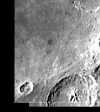 |
Dark Haloed
Lunar Craters (DHC). The
moon has several dozen small
craters that are surrounded by
darker material. Not much is
known about the cause of the dark
material; however, volcanic
emission seems to be one of the
leading theories. After
stumbling onto a pair of these in
Mare Nectaris, I have been
studying the contrast under
different lighting conditions to
gain some additional
insight. The relatively poor
seeing in our mid-Atlantic area,
and the small refractor, make this
study at the edge of
feasibility. Here is a
picture of the area, somewhat
enhanced. Theopholis (75 km dia)
is the large crater at the bottom
of the picture. The upper
DHC is about 3 miles in diameter,
the lower one is about half that,
and not easy to see under this
lighting. |
 |
M57.
Stimulated by the excellent
picture on the right by a well
known astrophotographer, I
took the picture on the left with
my 6 inch. Clearly the right
hand picture is better, but the
left hand shows that with effort
you can still do good work with a
small scope. Exposure was
about 2 hours. |
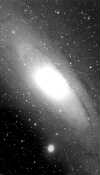 |
M31, The
Great Galaxy in Andromeda.
This is a group of three
exposures with 20 min.
exposures at f4. The mosaic
was put together using MaximDL
(first attempt). With
heavier processing, one can bring
out more of the central region, if
desired. |
Click
for image of comet
|
Comet 2002 (Ikeya-Zha). UL Comet
on June 9, 2000 shows some faint
anti-tail to the right. To
show the tails more clearly, I
averaged 16 comet images each
rotated 22.5 deg, then subtracted
from the original giving UR
image. On Jun 21, in strong
moonlight, I took 30x1 min exp,
median combined. The comet has
about half its former
brightness. Background
moonlight is about 9x the background
of the June 9 image. Even so,
with no processing, one sees a much
sharper and relatively brighter
anti-tail to the west (right,
sunward) as we pass through the
plane of the sun-comet-earth.
In the one minute exposures, the
anti-tail is about 10 counts out of
about 2000 background, the comet
nucleus is about 500 counts above
background. |
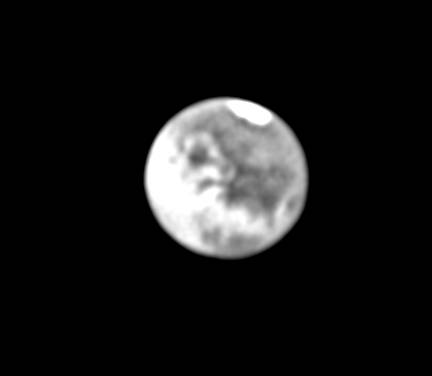 |
Mars, taken August 24, 2003.
Black and white image compared to a
drawing done a few days
earlier. (Please read the text
below images for more details.) |
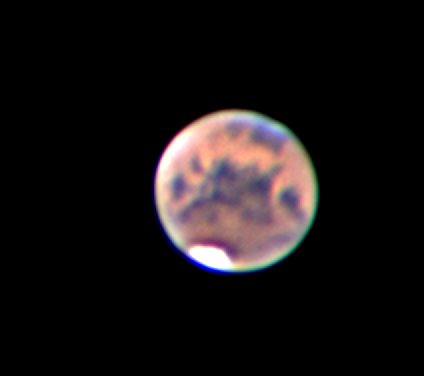 |
Images of Mars on August 25,
2003. Color vs. back and
white. (See text below images for
further description.) |
top
Light Curve
Measurements - asteroids and variable
stars
Most
asteroids are not perfect spheres, so as
they rotate, their oblong shapes reflect
different amounts of sunlight back to
us. Thus, even though we
cannot actually see an asteroid, we can
measure its
reflected light, and this allows us to
infer its rotation time. Amateurs
take the lead in this work, and many of
us measure scores of asteroid light
curves each year. Not only are
asteroid rotation rates interesting in
themselves (why not faster? why
not slower?), after several years of
measurements, it is often possible to
use the data to infer the actual shape
of the asteroid.
I show
below a small sample of the asteroids I
have measured. The results have
been published in Minor
Planet Bulletin. I have also
written papers on some of the techniques used
in this work.
My work on
light curves of variable stars follows
the asteroid list.
Asteroid
|
Description
|
1116
Catriona
|
My first asteroid
lightcurve measurement. I was
so-o-o-o green, but even a rank
amateur with persistence can achieve
useful results.
|
27496
(no name)
|
A faint asteroid, also one
of my first. The results are
not very trustworthy.
|
1016
Anitra
|
Bright, fast, easy, fun!
|
808
Merxia
|
A bright asteroid, a
beautiful curve.
|
471
Papagena
|
A fast rotator, bright.
|
582
Olympia
|
Moderately bright object
with a 72-hour rotation, making this
VERY difficult. Multiple
observers have worked on Olympia.
|
2283
Bunke
|
Faint (nearly 15 mag) but
fast (4 hours). It pushed my
skills and equipment to the
limit.
|
|
|
|
|
|
|
|
|
|
|
|
|
|
|
|
|
|
|
|
|
This
paper reports observations of the
near earth asteroid 2010 AL30,
discovered in January 2010 only days
before it passed by our
planet. I include a light
curve and discussion of
measurements.
(PDF file,
373K)
|
|
|
|
|
Below are measurements of selected
variable stars. Some variables
produce light curves that look similar
to asteroid light curves, but of course,
there is considerably more to variables
than that. The best source of
information about variable stars is AAVSO,
the American Association of Variable
Star Observers, based in Cambridge,
MA. Despite its name, AAVSO is a
worldwide organization. It
maintains a significant archive of
observation data and collects new
observations that it makes accessible
through the AAVSO International
Database. The first paper listed
below describes a highly unusual
variable that AAVSO began targeting for
more data in March 2009.
|
|
Description
|
CSS081231
|
A cataclysmic
variable star with very fast eclipses.
Observations taken in May 2009.
(PDF file,
188K)
|
|
|
"A Neophyte's
Determination of EY Ceph Curves and
Orbital Constants" (PDF file,
185K).
This paper was presented
in May, 2002 at a meeting of the
International Amateur-Professional
Photoelectric Photometry-Western Wing
(IAPPP) in Big Bear, California. It
describes intitial measurements of the EY
Cephius eclipsing binary system.
|
U Sco Monitoring
|
"Monitoring U Sco"
(PDF
file, 657K)
U Sco is a recurrent nova with about ten years
interval. Predictions have been made that
a new eruption is imminent. Monitoring the star
is difficult because it is faint (18th
magnitude), low in our southern sky, and has a
very close field star. This paper
discusses how I handled the measurement
challenges.
|
top
Asteroid
Occultations
Asteroids, of course, move through space
in their orbits. As they travel,
they sometimes pass in front of stars we
can see, thus eclipsing the star and
casting a shadow onto the earth.
These events can be predicted, with the
paths and timing of the shadow path on
the earth accurate to a few tens of
miles and tens of seconds. If one
or several people set up observing
stations across the path of the shadow,
and if they measure the duration of the
eclipse, then it's possible to calcualte
the size and shape of the
asteroid. This work can be done
either from a fixed observatory, or from
portable equipment. This is a very
active field of study, with excellent
resources
on the web.
As of early 2009, I have attempted about
thirty occultation events: weather wiped
out about twenty of them. Half the
remainder failed due to equipment
problems or my human error. The
other half were successful, but in most
cases, the shadow did not pass over the
telescope, so the result was a "miss"
(this is often a very important
observation). In one case, I had a
"hit". This record of results
sounds worse than it is: as my skills
improve, I will see more "hits".
Here are three files that explain
occultation observing in more detail.
top
Asteroid
Occultation
Observations
|
A
power point presentation on the
addictive nature of observing
asteroid occultations. I
made this presentation at the 2009
meeting of The Society for
Astronomical Sciences (SAS) in Big
Bear, CA. It is a
presentation version of the paper
listed below. (Note the movie on
slide 17 won't play, but I've posted it on YouTube.)
(PDF file,
16.9M)
|
The Addictive Properties of
Occultations
|
Paper
written for and published by the Society for Astronomical Sciences (SAS).
It was one of a pair of papers on
this topic at the annual meeting
of SAS, held in Big Bear, CA in
May 2009.
(PDF file,
7M)
|
Detecting
Occultations Buried in Noise
|
This
paper describes using Excel
software techniques to determine
whether an occultation signal is
present in noisy data. Both
real and pseudo-data are used as
examples.
(PDF
file,
511K)
|
|
|
top
Spectra
Here are a few spectral studies of
comets. More to come. I've also
created an online archive of
spectral images for objects other than
comets I invite you to read the
paper on the techniques and the set-up I
use when doing spectra.
9P/Tempel1
Spectrum
|
|
"Spectrum
of Tempel1"
(PDF file, 40K)
Spectrum taken on July 2, 2005 using
DSS7 Spectrometer. Very poor
signal to noise, but the comet was
faint: an interesting first
try. See below for better
results.
|
Spectroscopy
Techniques
I
|
|
"Spectroscopy
Techniques".
(PDF file, 551K)
This paper describes my earliest
setup using a C11 and DSS7/402
combination to observe astronomical
spectra. I also discuss
briefly some of the challenges of
the operations, as well as
corrections needed to make the
spectra useful. Current
techniques are described below.
|
Spectroscopy
Techniques
II
|
|
"Spectroscopy
Methods Summary"
(PDF
file, 692K)
This paper, written in Fall, 2010,
describes my current observation and
analysis methods using the 18-inch
Newtonian and DSS-7, controlled by
custom software. I no longer
use the C-11 for spectroscopy
because I need all the photons I can
get!
|
Spectroscopy
Techniques
III
|
|
"Spectroscopy
Processing:
The Video"
(AVI file, 76M)
This 30-minute video shows how I use
MaximDL and Excel to process
sprectroscopic images and convert
the data to graphical output.
The video demonstrates techniques
described in the paper "Spectroscopy
Methods Summary", above.
|
Examples
of Spectra, v.3
|
|
"Examples
of Spectra".
(PDF file, 1.1M)
This paper gives some of my
spectroscopic observations of
various objects, including M57, and
Comets C073 and Comet Swan.
|
Comet
17P Holmes - Spectra
|
|
Comet
17P Holmes - Spectra and Images
(PDF file, 1.5M)
Images and spectra of Comet Holmes -
through November 29, 2007
|
Comet
17P Holmes - Coma
|
|
Comet
17P Holmes Coma Study
(PDF file, 800K)
An analysis of the coma
density, including models and
measurements of transparency
during the first eleven days
after outburst.
|
Comet
Lulin
|
|
Spectrum
of Comet Lulin, taken February 23,
2009, with comparison to Comet Swan
spectrum.
(PDF file, 478 K)
|
Nova Scorpii
2011
|
|
Spectra
and photometry of this nova
discovered June 1, 2011 by John
Seach in Australia. My spectra
were the earliest taken and
submitted to AAVSO following the
discovery of the nova.
(PDF file, 376K)
|
V1312Sco
|
|
Here
is an update on Nova Scorpii
2011: this paper, written in
September 2011, presents more light
curves, more spectra. The nova
is now officially designated as
V1312Sco, a new name to go with new
data.
(PDF
file, 1.8M)
|
AZ
Cas pdf
AZ Cas
ppt
|
|
AZCas is an eclipsing
variable encompassing a cool M star
and a hot B star. The system
shows occasional events lasting
hours to days. The pdf
document describes the work to date,
while the power point contains JPGs
of all the spectra to date. Each file
is under
1MB in size.
|
top
Astronomy
Equipment and Software
One of my great loves is working in the
shop, taking an idea for a new
elelctronic device or observing tool or
software program from concept to
reality. I also enjoy solving
problems with equipment I'm using, or
analyzing why some products work the way
I expect them to, but some don't.
Here is a selection of papers on
equipment related subjects. These
include descriptions of equipment,
evaluation of various designs or
products, better methods of making
particular measurements, how I built the
18-inch telescope, etc. Enjoy!
top
|
Flats
|
"Are Flats Really Flat?"
(PDF file, 42K).
I discovered a characteristic of the
ST7E camera in which internal
reflections in the camera can create
a 2% gradient in the flat. Use
of the flat for calibration can then
introduce an error when performing
high precision photomertic
analysis. We show that a
simple mask can prevent this
effect. |
|
C11
Mirror Flop
|
"C11 Upgrade"
(PDF file, 20K)
Although the optics of the C11 were
excellent, I was experiencing image
shift as the scope moved to
different positions. I modified the
mirror cell of the scope to reduce
mirror flop. This paper
describes the results. |
More on
Flats
|
"Just
How Good are Flats?"
(PDF file, 987K)
This paper reports
research done on flats used in CCD
Photometry. I
measured how well different types
of flats could, in fact, correct
an image. The
work shows how to separate out the
effects of camera, optics, and
flat source.
This PDF is the first half
of a paper given at the 2005
meeting of the Society for
Astronomical Science, and is
copyrighted by SAS.
The complete original paper
can be retrieved at http://www.socastrosci.org/Files/SAS_Proceedings_2005.pdf |
StarZap
|
"StarZap:
A Method of Removing Unwanted Stars"
(PDF file, 39K)
StarZap is an
automated program that can remove
stars that interfere with the
measurement of asteroid
brightness. The
program uses tools available in
MaximDL. This PDF (with
slight modifications) is the
second half of the paper described
above. The
program and source code (VB6) are
open source and available free. Click
here to download the
installation zip file, which
includes an essential "READ ME"
file.
|
Spectroscopy
Techniques
|
"Spectroscopy
Techniques".
(PDF file, 551K)
This paper describes my setup using
a C11 and DSS7/402 combination to
observe astronomical spectra.
I also discuss briefly some of the
challenges of the operations, as
well as corrections needed to make
the spectra useful.
|
Drift
Scan-o-meter
|
Drift
Scan-o-meter
(PDF file, 884K)
A new method of performing a
drift scan to measure asteroid
occultations. |
Flats
Revisited
|
Flat
Errors Are Not the Problelm
(PDF file, 377K)
Demonstrating how some "huge
errors" in a flat source can
sometimes make no difference.
Surpirse! |
18-inch,
f3.5 Newtonian
|
Fast
Newtonian Scope for Photometry and
Imaging
(PDF file, 8.6M)
This paper describes
construction, testing and operation
of an 18-inch f3.5 Newtonian
telescope, brought into service in
2007. |
Remote
Scope Cover
|
Remote
Operated Scope Cover System
(PDF file, 1.3M)
Construction of a
remotely operated telescope cover
(for the scope described above) and
associated electronics.
|
Comparing
Video Cameras
|
How
effective are new, more sensitive
video cameras for occultation
measurements? This paper
reports my findings when I compared
four cameras in six tests.
Results suggest that the increased
sensitivity in some models is more
usesful than in others.
(PDF file, 4.4 M)
|
Mintron
Camera Timing Logic
|
The
Mintron is a video camera with
integrating capability. This
paper describes a study that
explores the timing logic when the
camera is used in integrating
mode. My results show that the
integration mode causes a
substantial delay in the output
signal but no other delays.
This finding is relevant when
determining uncertainties in timing
occultation and similar astronomical
events.
(PDF file,
1.4 M)
|
|
|
This
paper describes construction and
testing of an instrument for fast
photometry. The instrument has
been tested both on the bench and
with stars. Paper includes
photos and schematic.
(PDF file,
4.1M)
|
|
This
paper describes how to extend the
long wavelength limit of the DSS7
from the usual 7500A to
>9000A. Using an ST7 or
ST402 requires a simple
modification, while an ST1603
requires none. The paper also
describes my DSS7 Control Program,
available as a free
download here for your
experimentation.
(PDF file, 1M)
|
Fast
Spectrometer
Construction
|
In
2011-12, I built a spectrometer to
match the optical characteristics of
my 18-inch, f3.5 Newtonian telescope
(described above). This paper
shares the steps in design,
construction and initial testing of
the "FS-1".
(PDF
file, 5.6M)
|
Fast
Spectrometer
Performance
|
Here
is the paper I presented at the May
2012 meeting of the Society for
Astronomical Sciences in Big Bear,
CA. It describes
observations that demonstrate some
of the capabilities of the
instrument.
(PDF file, 2.8M)
|
Research
with Fast Spectrometer
|
The paper describes
two projects: (1) researching the RV
curve of the pulsating star BWVul
for an RV signal of a faint star,
and (2) compiling the full 1.2-day
spectroscopic signal of SigOriE, a B emission
star. I
presented these
results at the May
2013 meeting of the
Society for
Astronomical Sciences,
Big Bear CA.
(PDF
file, 1.1M)
|
Spectrometer
Wavelength
Calibrator
|
In summer 2013, I
constructed a wavelength calibrator
for use with the fast spectrometer
described above. The calibrator
uses small ampoules of gas excited
externally from a 12V:2KV power
supply, all at a cost of about
$100.
(PDF file, 3.2M)
|
|
|
top
Papers on topics
other than astronomy
The world has other challenges besides
understanding the universe. I've
given much thought recently to Global
Warming and related non-astronomy
issues.
|
|
Can
Global Warming be Stopped?
This Power Point presentation
outlines a very pessimistic (but
realistic) view of our future
ability to cope with global warming.
(PDF file, 1.1M)
|
A Heretic's
View of the 7th Principle
|
This
is a lay sermon that analyzes the
Unitarian-Universalist 7th Principle
(concerning the interconnected web
of existence) from a very different
point of view than is common.
The sermon discusses global warming
as a major example.
(PDF file, 140 K)
|
|
This
paper analyzes energy sources that
could substitute for fossil
fuel. The conclusion is that
only nuclear electricity and
conservation can meet the major
needs of the world in the short
(40year) time available.
(PDF file, 116 K)
|
Global
Warming: Poppycock???
|
This
paper is targeted at readers who are
reluctant to accept that global
warming is real. It confronts
some of the current claims that
scientists are wrong about global
warming.
(PDF file,
316K)
|
Tee
Shirt Flipping Study
|
This
paper explores the long-standing
question of what makes clothes turn
inside out in washing
machines. Data collected
during 2009 reveal a 30% flipping
rate.
(PDF file, 1.7M)
|
|
The
small Sentry Firesafe in the office
of a volunteer organization would
not open due to a stuck
handle. I brought it home to
investigate. This paper
describes (with photos) how the safe
works and suggests maintenance that
may be needed.
(PDF
file, 8M)
|
|
One
lucky day, I found a 1978 Motron
moped on a pile of discards. I
invested a modest amount of
time and money restoring it to
operating condition. This paper
describes my moped adventures with
text and photos and explains why I
chose to "soup it up" for fun and
safety.
(PDF file, 13M)
|
|
|
top
|
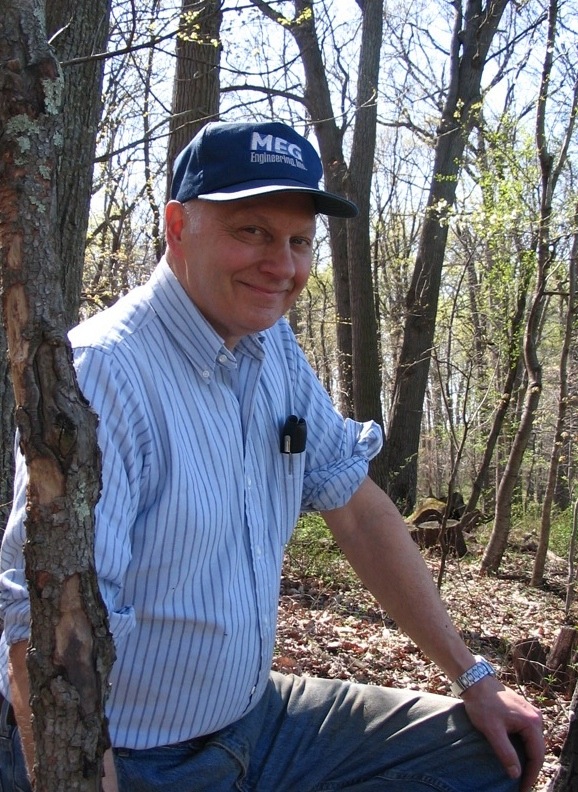 MenkeScientific
MenkeScientific
 MenkeScientific
MenkeScientific